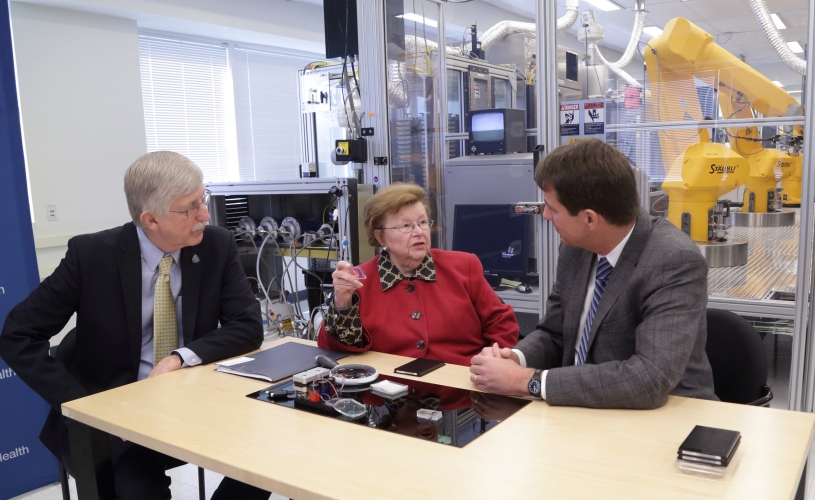NIH: Alzheimer’s disease research is among the many areas of biomedical
science that Senator Barbara Mikulski has championed during her nearly
40 years on Capitol Hill. And it’s easy to understand why the Senator is
concerned: an estimated 5 million Americans age 65 and older have
Alzheimer’s disease, and those numbers are expected to rise
exponentially as the U.S. population continues to age.
So, I was thrilled to have some encouraging progress to report last
week when Senator Mikulski (D-MD) paid a visit to NIH’s National Center
for Advancing Translational Sciences (NCATS) in Gaithersburg, MD. After a
whirlwind tour of the cutting-edge robotics facility for high
throughput screening of small molecules, she joined me and NCATS
Director Dr. Chris Austin in announcing that, thanks to an innovative
public-private partnership, an experimental drug originally developed to
fight cancer is now showing promise against Alzheimer’s disease.
The compound, called saracatinib, is
particularly exciting because it acts through a different mechanism than
other experimental therapies now being tested for Alzheimer’s disease.
The biopharmaceutical company AstraZeneca, which has agreed to supply
the drug for the trials, first developed the compound to target a family
of enzymes called src kinases, which are involved in the
spread of cancer. Although the oral drug proved safe in human clinical
trials, its performance was not impressive against cancer. So, the
company shelved saracatinib, setting aside plans for further
development.
That’s where the drug might have stayed had it not been for a basic
research discovery made by a team led by Stephen Strittmatter of Yale
University School of Medicine, New Haven, CT. Just a couple of years
ago, in work involving a mouse model of Alzheimer’s disease [1], the
neuroscientist and his colleagues discovered that a related kinase
called Fyn may play a key role in the catastrophic changes in cellular
architecture that take place in Alzheimer’s disease.
Specifically, Strittmatter’s group found that misfolded beta amyloid
protein—a major component of the plaques seen in the brains of people
with Alzheimer’s disease—interacts with another protein to activate Fyn
excessively. This over-activation appears to spur the loss of neuronal
synapses, which are essential for the communication of thoughts and
formation of memories. The scientists reasoned that by blocking Fyn,
they might be able to halt the destruction of synapses. But they needed a
precisely targeted compound to do the job. They wondered whether
saracatinib might do the trick, but that drug seemed out of reach
because it was the exclusive property of AstraZeneca.
Enter the Discovering New Therapeutic Uses for Existing Molecules program, which was launched by NCATS less than two years ago.
This pioneering partnership between NIH and industry provides an avenue
for pharmaceutical companies to allow compounds that have failed along
the way to be made available to the scientific community for other
applications. The aim is to identify new uses for drugs already known to
be safe in animals and humans, thereby reducing the time spent on
safety testing and speeding the development of new therapies for
patients in need.
By partnering with AstraZeneca through the New Therapeutic Uses
program, the Yale team was able to obtain saracatinib at no cost and
confirm that the compound does indeed block the Fyn kinase implicated in
Alzheimer’s disease. In their recent study published in the Annals of Neurology
[2], the researchers found that when they gave saracatinib to mice with
Alzheimer’s-like symptoms for 4 weeks, they could turn off Fyn, get
brain synapses firing again, and, most impressively, reverse memory loss
in the animals. Because saracatinib had already passed human safety
tests when it was evaluated for cancer, the researchers were able to
assess its safety, tolerability, and dosing very quickly in a small
number people with Alzheimer’s [3]. Now, they are busy enrolling
patients in a Phase 2a placebo-controlled clinical trial that will
evaluate the effectiveness of saracatinib in about 150 people with mild
Alzheimer’s disease [4].
What’s truly remarkable about this progress is that the Yale and
AstraZeneca partners finished preclinical work, updated human safety
studies, and began human efficacy studies, all within 18 months. That’s
phenomenal when you consider that the average time for taking a compound
from target discovery to human efficacy testing is currently about a
decade!
Besides saracatinib, NIH-funded researchers are pursuing many other
encouraging leads for treating and preventing Alzheimer’s disease. One
that I’ve highlighted in the past
is the Accelerating Medicines Partnership (AMP). The goal of this
public-private effort, which involves NIH, industry, and nonprofit
organizations, is to catalyze the identification of better biological
targets and markers to enable the development of better drugs at a
faster pace. AMP is starting with pilot projects in three disease areas,
including Alzheimer’s.
NIH research is also vital to realizing the vision set forth in the National Plan to Address Alzheimer’s Disease.
As part of this effort, we are supporting basic research in
neuroscience, epidemiology studies to identify genes that raise or lower
risk of developing the disease, and more than 25 clinical studies aimed
at improving methods for early diagnosis and tracking disease
progression.
References:
[1] Alzheimer amyloid-β oligomer bound to postsynaptic prion protein activates Fyn to impair neurons. Um JW, Nygaard HB, Heiss JK, Kostylev MA, Stagi M, Vortmeyer A, Wisniewski T, Gunther EC, Strittmatter SM. Nat Neurosci. 2012 Sep;15(9):1227-35. doi: 10.1038/nn.3178.
[2] Fyn inhibition rescues established memory and synapse loss in Alzheimer mice.
Kaufman AC, Salazar SV, Haas LT, Yang J, Kostylev MA, Jeng AT, Robinson
SA, Gunther EC, van Dyck CH, Nygaard HB, Strittmatter SM. Ann Neurol. 2015 Feb 23. doi: 10.1002/ana/24393 [Epub ahead of print]
[3] Safety and tolerability of AZD0530 (saracatinib) in Alzheimer’s disease. ClinicalTrials.gov
[3] A phase IIa multi-center study of 18F-FDG PET, safety, and tolerability of AZD0530 in mild Alzheimer’s disease. ClinicalTrials.gov
